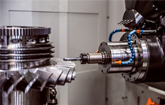Human-like Hands Key to Robonaut 2's Dexterity
WARREN, Mich., Dec. 8, 2010 /PRNewswire/ -- Great hands. Elite athletes have them, and they are a standout characteristic of Robonaut 2.
In fact, R2 as he is known to his creators is one of the most dexterous robots ever built because of his very human-like hands. Engineers from the General Motors Technical Center in Warren, MI and NASA's Johnson Space center in Houston collaborated to produce a robot that could work side-by-side with human astronauts at the International Space Station as well as future missions.
Since all of the tools and equipment aboard the space station were designed for use by human hands, R2 had to be able to perform tasks using the same tools.
R2's mechanical hands work very much like the human hands on which they were modeled, including a similar range of motion and precise control of both position and force.
"R2's arms and hands have a jointed skeleton similar to a human," said Marty Linn, GM principal robotics engineer, "although the thumbs have four degrees of freedom, almost like a human." It is widely believed that the opposable thumb was one reason why early humans could develop the ability to use tools. R2's hand was designed to incorporate this capability.
Unlike many previous humanoid robots, R2 has slim fingers and thumbs resembling those on human hands. Just as human tendons attach muscle to bone, R2 has tendons to connect the skeletal joints to sensors and actuators in the palm. This allows R2's control systems to precisely sense the reaction forces and continuously adjust the grip of the hand for whatever task R2 is performing.
While traditional industrial robots are designed to precisely place objects or follow a specific path, they don't handle unexpected objects or items slightly out of position very well. Humans have a much greater ability to adapt to variation, and the design of R2's hands and control systems provide him with similar capabilities. R2 shows off this capability when he shakes hands with visitors. No matter what size hand or the firmness of the grip, R2 automatically adjusts.
"We've invested some of our best and brightest minds to the creation of R2," said Ken Knight, GM executive director, global manufacturing engineering. "Working with NASA's scientists and engineers we are confident we have created the most technologically advanced robot in the world."
Whether R2 is wiping down hand rails in the space station, where he is scheduled to travel in February 2011, or helping astronauts assemble new modules for the station – or someday helping in a manufacturing environment – the dexterity enabled by his hands will allow him to outperform predecessors hands down.
About General Motors – General Motors Company (NYSE: GM, TSX: GMM), one of the world's largest automakers, traces its roots back to 1908. With its global headquarters in Detroit, GM employs 209,000 people in every major region of the world and does business in more than 120 countries. GM and its strategic partners produce cars and trucks in 31 countries, and sell and service these vehicles through the following brands: Buick, Cadillac, Chevrolet, GMC, Daewoo, Holden, Isuzu, Jiefang, Opel, Vauxhall, and Wuling. GM's largest national market is China, followed by the United States, Brazil, the United Kingdom, Germany, Canada, and Russia. GM's OnStar subsidiary is the industry leader in vehicle safety, security and information services. General Motors acquired operations from General Motors Corporation on July 10, 2009, and references to prior periods in this and other press materials refer to operations of the old General Motors Corporation. More information on the new General Motors can be found at www.gm.com.
SOURCE General Motors
WANT YOUR COMPANY'S NEWS FEATURED ON PRNEWSWIRE.COM?
Newsrooms &
Influencers
Digital Media
Outlets
Journalists
Opted In




Share this article